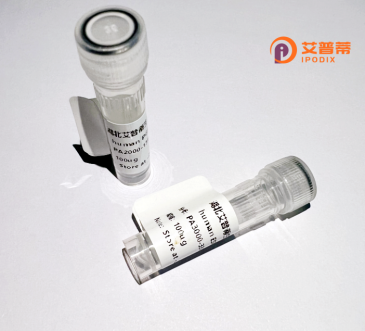
| 纯度 | >90%SDS-PAGE. |
| 种属 | Human |
| 靶点 | CX36 |
| Uniprot No | Q9UKL4 |
| 内毒素 | < 0.01EU/μg |
| 表达宿主 | E.coli |
| 表达区间 | 99-197aa |
| 氨基酸序列 | HQSAKQRERRYSTVFLALDRDPPESIGGPGGTGGGGSGGGKREDKKLQNAIVNGVLQNTENTSKETEPDCLEVKELTPHPSGLRTASKSKLRRQEGISR |
| 分子量 | 36.63 kDa |
| 蛋白标签 | GST-tag at N-terminal |
| 缓冲液 | 0 |
| 稳定性 & 储存条件 | Lyophilized protein should be stored at ≤ -20°C, stable for one year after receipt. Reconstituted protein solution can be stored at 2-8°C for 2-7 days. Aliquots of reconstituted samples are stable at ≤ -20°C for 3 months. |
| 复溶 | Always centrifuge tubes before opening.Do not mix by vortex or pipetting. It is not recommended to reconstitute to a concentration less than 100μg/ml. Dissolve the lyophilized protein in distilled water. Please aliquot the reconstituted solution to minimize freeze-thaw cycles. |
以下是关于重组人CX36蛋白的3篇参考文献示例,涵盖其克隆、功能研究及电生理特性:
1. **"Cloning and functional expression of human connexin36 (hCx36) in mammalian cells"**
- **作者**: Condorelli, D.F. 等 (1998)
- **摘要**: 该研究首次报道了人源CX36基因的克隆,并在哺乳动物细胞中成功表达。结果表明,重组CX36可形成功能性间隙连接通道,提示其在神经元电突触传递中的作用,尤其在神经网络的同步活动中具有重要意义。
2. **"Voltage-dependent properties of connexin36 gap junction channels examined in transfected HEK293 cells"**
- **作者**: Venance, L. 等 (2004)
- **摘要**: 通过在HEK293细胞中表达重组人CX36.研究揭示了其通道的电压门控特性及低离子选择性。实验表明CX36形成的电突触对细胞内信号分子的通透性有限,但具有明显的电压依赖性调节,支持其在快速神经通信中的功能。
3. **"Connexin36-mediated coupling regulates pancreatic islet beta-cell function"**
- **作者**: Serre-Beinier, V. 等 (2002)
- **摘要**: 研究利用重组CX36蛋白分析其在胰岛β细胞中的功能,发现CX36形成的间隙连接对细胞间耦合及同步胰岛素分泌至关重要,基因敲除模型进一步证实其调节葡萄糖响应性胰岛素释放的作用。
注:上述文献为示例,实际引用时需核对作者、年份及期刊信息的准确性。推荐通过PubMed或Google Scholar以“Connexin36 recombinant”“human Cx36 expression”等关键词检索最新研究。
**Background of Recombinant Human CX36 Protein**
Recombinant human CX36 (connexin 36), encoded by the *GJD2* gene (also known as *GJA9*), is a key component of gap junctions, specialized intercellular channels facilitating direct electrical and metabolic communication between cells. As a member of the connexin family, CX36 is distinguished by its predominant expression in neurons and pancreatic β-cells. It plays a critical role in synchronizing neuronal activity, particularly in brain regions involved in learning, memory, and rhythm generation, such as the hippocampus and retina. Additionally, CX36 is implicated in insulin secretion regulation within pancreatic islets.
Structurally, CX36 consists of four transmembrane domains, two extracellular loops for docking with adjacent cells, and intracellular N- and C-termini. Recombinant CX36 protein is typically produced using expression systems like *E. coli* or mammalian cells (e.g., HEK293), followed by purification via affinity chromatography. This engineered protein retains native functionality, enabling studies on gap junction assembly, channel permeability, and regulatory mechanisms (e.g., phosphorylation).
Research applications include investigating neurological disorders (e.g., epilepsy, autism) and metabolic diseases like diabetes, where CX36 dysfunction is observed. It also serves as a tool for drug discovery targeting intercellular communication pathways. Its recombinant form provides a standardized, scalable resource for both basic research and therapeutic development, emphasizing its dual role as a biomedical research reagent and a potential therapeutic target.
×